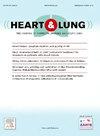Baseline characteristics and in-hospital mortality predictors in female patients on venovenous extracorporeal membrane oxygenation: Impact of pregnancy
IF 2.6
4区 医学
Q2 CARDIAC & CARDIOVASCULAR SYSTEMS
引用次数: 0
Abstract
Background
Venovenous extracorporeal membrane oxygenation (VV-ECMO) is often used for lung rest in critically ill patients, including pregnant patients.
Objectives
We aimed to determine how pregnant and non-pregnant patients requiring VV-ECMO differed from each other and how pregnancy impacted in-hospital mortality.
Methods
We used the National Inpatient Sample to identify a cohort of female patients requiring VV-ECMO from 2016 to 2021, stratified by pregnancy status. Baseline characteristics were compared using Pearson chi-square test. Predictors of in-hospital mortality, including pregnancy and complications from VV-ECMO, were determined using multivariate analysis with a logistic regression model.
Results
Of 7365 female patients requiring VV-ECMO, 700 (9.5 %) were pregnant. Pregnant patients were younger. COVID-19 was more prevalent in pregnant patients (72.9 % versus 36.4 %, p < 0.001). Infectious complications were more common in non-pregnant patients (64.1 % versus 43.6 %, p < 0.001). Pregnant patients suffered from less in-hospital mortality (20.0 % versus 38.5 %, p < 0.001), and pregnancy predicted survival (adjusted odds ratio (OR): 0.49 [0.27–0.89], p = 0.02). Length of stay ≥7 days and COPD were associated with reduced odds of in-hospital mortality; chronic heart failure, COVID-19, and VV-ECMO complications were associated with increased odds of in-hospital mortality.
Conclusions
These findings underscore the unique clinical profile and outcomes of pregnant females requiring VV-ECMO, highlighting the need for tailored management strategies. Prospective studies are essential to validate these observations and optimize care for this vulnerable patient population.
静脉-静脉体外膜氧合女性患者的基线特征和住院死亡率预测因素:妊娠的影响
背景静脉-静脉体外膜氧合(VV-ECMO)常用于危重患者,包括妊娠患者的肺休息。目的:我们旨在确定需要VV-ECMO的妊娠和非妊娠患者之间的差异,以及妊娠对住院死亡率的影响。方法:我们使用全国住院患者样本,确定2016年至2021年期间需要VV-ECMO的女性患者队列,按妊娠状况分层。基线特征比较采用Pearson卡方检验。采用logistic回归模型进行多因素分析,确定院内死亡率的预测因素,包括妊娠和VV-ECMO并发症。结果7365例需要VV-ECMO的女性患者中,有700例(9.5%)为孕妇。孕妇更年轻。COVID-19在孕妇中更为普遍(72.9%比36.4%,p <;0.001)。感染并发症在非妊娠患者中更为常见(64.1%对43.6%,p <;0.001)。孕妇的住院死亡率较低(20.0%对38.5%,p <;妊娠预测生存率(校正优势比(OR): 0.49 [0.27-0.89], p = 0.02)。住院时间≥7天和COPD与院内死亡率降低相关;慢性心力衰竭、COVID-19和VV-ECMO并发症与院内死亡率增加有关。这些发现强调了需要VV-ECMO的孕妇的独特临床特征和结果,强调了定制管理策略的必要性。前瞻性研究对于验证这些观察结果和优化这一弱势患者群体的护理至关重要。
本文章由计算机程序翻译,如有差异,请以英文原文为准。
求助全文
约1分钟内获得全文
求助全文
来源期刊

Heart & Lung
医学-呼吸系统
CiteScore
4.60
自引率
3.60%
发文量
184
审稿时长
35 days
期刊介绍:
Heart & Lung: The Journal of Cardiopulmonary and Acute Care, the official publication of The American Association of Heart Failure Nurses, presents original, peer-reviewed articles on techniques, advances, investigations, and observations related to the care of patients with acute and critical illness and patients with chronic cardiac or pulmonary disorders.
The Journal''s acute care articles focus on the care of hospitalized patients, including those in the critical and acute care settings. Because most patients who are hospitalized in acute and critical care settings have chronic conditions, we are also interested in the chronically critically ill, the care of patients with chronic cardiopulmonary disorders, their rehabilitation, and disease prevention. The Journal''s heart failure articles focus on all aspects of the care of patients with this condition. Manuscripts that are relevant to populations across the human lifespan are welcome.
 求助内容:
求助内容: 应助结果提醒方式:
应助结果提醒方式:


